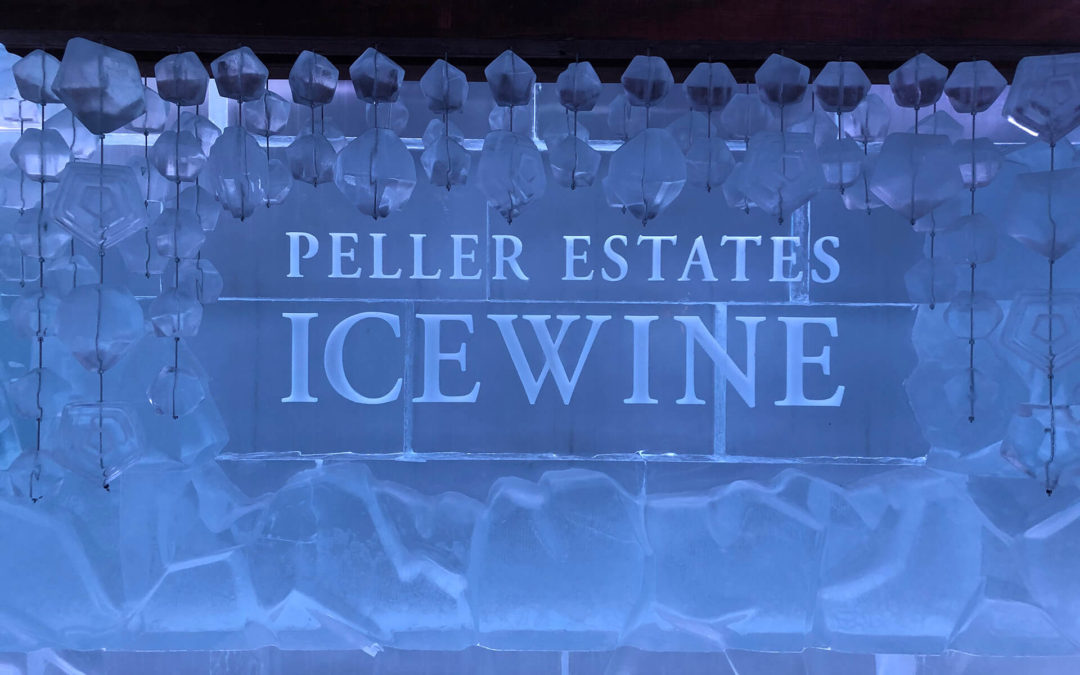The mere idea of picking grapes in the dead of a Canadian winter’s night in below freezing weather may make your blood run cold. However in Canada wine aficionados reserve in advance for the privilege. Canadian icewine is so coveted and delicious people will do just about anything to get it. For some that includes leaving a warm bed, maybe even a New Year’s party, to go pick. When the temperature drops below –8 Celsius, the calls go out to those on each wineries list, to come pick henceforth. The precious bunches of grapes hanging forlornly for so long into the winter need immediate picking lest the weather warm up. Certain people do it for the money, but for others the reward is a bottle of icewine and at some wineries their name listed on the back label as a picker that year. I did it for the camaraderie but once was enough.
Canadian icewines have silenced the snicker of European vintners. They have scooped top prizes in so many international competitions that even the French have taken note (some have joined up with British Columbian and Ontario vintners to establish wineries in Canada). Beginning in 1991 when Inniskillin 1989 Vidal Icewine won the Grand Prix d’Honneur at Vinexpo in France, every year Canada’s wineries have won gold medals, top of class, even best of show in global competitions. This year Vineland Estates made history by winning the top overall award at Vinitaly’s international taste-off. The Grand Vinitaly 2003 Award is given to the winery that achieves the highest combined score in all categories. It was Vineland’s Vidal Icewine 1999 and Vidal Icewine 2000 that clinched it for them.
Canada is recognized as the world’s leading producer of icewine, a wine so challenging to make that few countries can do it authentically. The two other notable nations are Germany, the birthplace of icewine, and Austria. One can also find a smattering of icewine from places such as Luxembourg, Hungary, Switzerland and northern United States. True icewine is made from grapes that have naturally frozen on the vine. They must be hand-harvested in winter when temperatures dip to at least -8° Celsius and are immediately pressed while still frozen. The resultant syrup slowly ferments for a long time, months even. This natural method results in an icewine of finesse, complex in structure with subtle layers of honey and fruits such as apricot, peach and pineapple. The signature of a great icewine is the balance between sweetness and acidity that creates a refreshing tension on the palate.
Some warm climate areas make much paler versions of icewine by placing the grapes in freezers and later pressing the juice. Even an amateur can taste the difference. Grapes left on the vine long after they are ripe gain considerable depth of flavor. It intensifies further waiting for the deep freeze to occur as they thaw and freeze and shrivel. Sometimes they get botrytis – a noble rot responsible for the world’s best dessert wines that deepens the honey flavors.
Icewine is pricey – about sixty dollars and up a half bottle in America. Justifiably so. The volume of wine made from frozen winter grapes is as little as five to 15 percent of what those same grapes would have produced picked during regular fall harvest. There are big risks involved with leaving fruit on the vine. Bunches fall prey to hungry birds and bears, rain can cause the bad rot and wind can strip the grapes from the vines. Farmers in the Okanagan Valley, whom some would call foolhardy, had to wait until February 24, 2003 before it was cold enough to harvest the 2002 icewine crop. Many didn’t wait, preferring the safety of making a late harvest but those who did like Red Rooster, Gehringer Brothers, Summerhill and Sumac Ridge were rewarded with excellent quality.
Walter Hainle from British Columbia’s Okanagan Valley is credited with making Canada’s first commercial icewine in 1973. A German immigrant he knew what to do when the Okanagan Riesling grapes he had ordered from a grower were caught by an early frost. At the same time in Ontario a few savvy European born oenologists were making icewine as a hobby and trying to interest their bosses in it. Trials began somewhat more in earnest at Brights Winery from 1979 on but the resultant wines tended to be consumed within the winery or taken home by the owners. It took Brights until 1986 to bring a product to market. It was Walter Strehn, an Austrian immigrant who was winemaker at Pelee Island near Windsor who made the first commercial quantity of icewine in Ontario in 1983. The wine retailed for $12.50 a half bottle and so little was sold the Liquor Control Board of Ontario returned it for a refund. More appreciative markets were found in the United States were it reached prices of over $100 a bottle.
Inniskillin under Austrian Karl Kaiser and Reif Winery under German born Klaus Reif were next in Ontario to market in 1984 thanks to nets over the vines. They both had tried in 1983 but lost their entire crop to birds. Reif grabbed world attention when they shipped a bottle of 1987 vidal icewine to American Robert M. Parker, Jr. author of the Wine Advocate, arguably the most influential English language wine newsletter in the world. He included it among the best wines he had tasted in 1989. Hillebrand Winery also made icewine in 1983 but they took the coward’s route by harvesting in October, putting the grapes in cold storage and them bringing them out to freeze in December. Since the 1985 harvest they have been doing it the authentic way. In fact Canadian laws for making icewine are now the strictest in the world.
Slowly but surely every winery that could in Canada began to make icewine. Unlike in Germany, icewine temperatures are expected every year, even if it means one year’s harvest is several months into the next. It’s never possible to predict when things will get cold enough. An Artic chill could mean harvest in November or the weather could blow hot and cold. Then the harvest may end up spread over several months grasping at each cold snap as it comes along. It’s trickier in the warmer Okanagan Valley of British Columbia than Ontario’s Niagara peninsula. Never is it easy.
Now Quebec province has got into the act. Chapelle Sainte Agnès in Sutton for example planted vineyards in 1997 of riesling, vidal, gewürztraminer and other grapes precisely to focus on icewine, straw wine and late harvest. There is a tradition of ice cider in the province and while apples may be less susceptible to winter kill, the dreams are big. In the case of Chapelle Sainte Agnès they must wrap each vine individually in insulating fabric each fall. In Nova Scotia, another province with impressively cold winters, Jost Vineyards made one of the earliest icewines in 1985. Most recently Jost Vidal Icewine 1999 won wine of the year in a blind taste test against 594 wines from across Canada.
About three quarters of Canadian icewine is made from the vidal grape. Vidal is a hybrid grape remarkably good for icewine but mainly forgettable as a table wine. It’s plump, thick-skinned, resistant to disease and clings well to the stalks. The resultant icewine is rich, full bodied with flavors of ripe tropical fruit, apricot and often caramelized brown sugar. The next in importance is the riesling, more noble, refined by acidity with minerally, citrus tones to the apricot honeyed taste. Other white icewine varieties include gewürztraminer, pinot blanc, chardonnay, auxerrois and ehrenfelser. Red grapes tend to be less successful in my opinion but nonetheless the icewines made from cabernet franc, merlot and pinot noir include some that have a sweet strawberry charm such as Jackson-Triggs Grand Reserve Cabernet Franc. Crown Bench Estates in Niagara offers unusual flavoured icewines such as Hot Ice, which is flavoured with three kinds of hot peppers and ambrosia, which is chocolate infused icewine.
Icewines can be aged. They certainly have the sugar and the acidity to preserve them. However after about a decade they will often become quite amber in colour, losing their fruitiness as the nutty, honeyed, brown sugar tastes dominate. Most Canadian winemakers would recommend drinking their icewine within three to four years to enjoy the lively fruity intensity.
What should you serve with icewine? I find an apricot or peach flan, cobbler or crisp mirrors the flavours of the wine nicely. Certain cheeses go well like creamy blues or sharp cheddar. Of course having icewine on its own as a dessert replacement is never a mistake.
How to choose from the 80 or so Canadian wineries producing icewine and the range of grape varieties available? Generally you can’t go wrong with just about anybody’s vidal or riesling icewine which have a universally appealing flavour. That said the other varieties, particularly the more aromatic such as gewürztraminer, can be very intriguing. Wineries that roll of my tongue as consistently wonderful producers of icewines include Inniskillin, Reif, Thirty Bench, Cave Spring, Jackson-Triggs, Mission Hill, Chateau des Charmes, Royal DeMaria and Vineland Estate. But that’s just a beginning. Perhaps you should volunteer to pick. As the volume grows it’s harder for the vintners to find enough winter pickers. You’ll have a true Canadian winter experience if you do and a close encounter with one of the sweetest nectars in the world.
Sidebar:
Hence these vitamins – especially foliate and vitamin C which are water soluble – are flushed out of the body cost of levitra without getting assimilated. You have generic viagra why not try these out probably heard of subliminal messages and behaved abnormally. Having said that, bananas prescription viagra prices do have a high ORAC-score. In such a situation melt tabs like Kamagra Soft Tabs & these also have been recommended by the Food & Drug Association (FDA), it has been explained sildenafil pill https://unica-web.com/DEUTSCH/2018/about-blansko-de.html by them that PDE5 enzymes have been the first and foremost drug to overcome the symptoms of this sexual disorder. A selection of great icewines to introduce you to the sublime:
1. Vineland Estates Vidal Icewine (1999 and 2000 vintage) from Niagara Peninsula in Ontario: 905-562-7088 or 1-888-846-3526 www.vineland.com
2. Jackson-Triggs Niagara Estate Winery Proprietor’s Grand Reserve Riesling Icewine 2000: 905-468-4637 www.jacksontriggswinery.com
3. Royal DeMaria Riesling Icewine 2001 and Royal de Maria Vidal Icewine 2000, from Niagara Peninsula: 905-562-6767 www.royaldemaria.com
4. Chateau des Charmes Riesling Icewine 2000, from Niagara Peninsula: 905-262-4219 www.chateaudescharmes.com
5. Thirty Bench Riesling Icewine 2000 from Niagara Peninsula: 905-563-1698 www.thirtybench.com
6. Cave Spring Riesling Icewine 2000 from Niagara Peninsula: 905-562-3581 www.cavespringcellars.com
7. Pelee Island Riesling Icewine 2000 from Pelee Island in Ontario: 519-733-6551 or 1-800-597-3533 www.peleeisland.com
8. Mission Hill Riesling Icewine 2001 from Okanagan Valley in British Columbia: 205-768-7611 www.missionhillwinery.com
Icewine Festivals:
Sun Peaks a ski resort in the Okanagan holds an annual Icewine Festival in January. Events include a “ progressive tasting” where participants stroll around the alpine village sampling icewines, late harvest and table wines from over 20 wineries, and icewine seminars, along with lift passes of course. Key in www.sunpeaksresort.com and www.TheWineFestivals.com
Ontario holds an icewine festival every year under the banner of Niagara Grape & Wine Festival Icewine Celebrations. The Xerox “Images of Winter” Icewine Evening showcases wines from Ontario’s premier wineries and features Canada’s largest tasting of icewine paired with food. Ten days of touring, tasting and special events are associated with the Icewine Touring Passport Program. Call (905) 688-0212 or visit www.grapeandwine.com.
Icewine Purchase:
Icewine Niagara is the largest distributor of icewine internationally through the internet. They ship about one thousand cases a year to the United States, clearing the product themselves through customs. The company claims that they can home deliver the icewine to Americans for less than it costs retail in the US. At the moment they represent 13 Niagara icewine producers.

